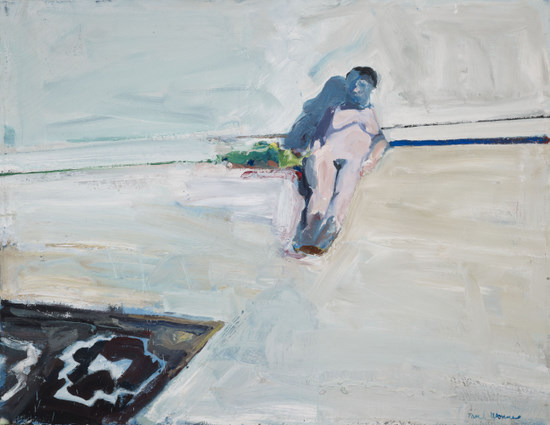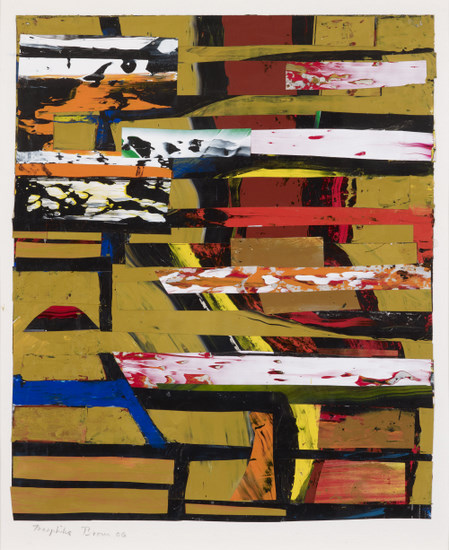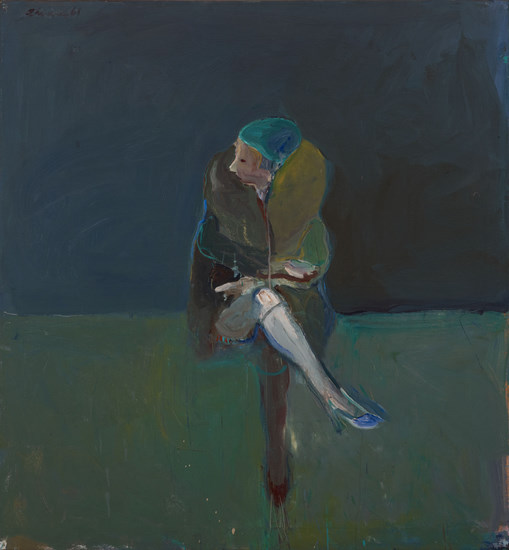The "Bay Area Figurative Style" goes back to the year 1950 when David Park submitted a heavily brushed painting of a jazz band -- "Rehearsal" -- to a group exhibition at San Francisco's De Young Museum. His representational painting looked so out of place among the field of Abstract Expressionist entries that it was thought to be a joke. It wasn't: it was a serious attempt at something new, a recognizable image painted with a vigor and spontaneity borrowed from abstraction.
At the time, San Francisco was then considered an artistic backwater, at least according to Clyfford Still who taught with Park at the California School of Fine Arts in Oakland. "Here I continue to paint in world of lethargy to art that is worse than outright death," Still wrote melodramatically to his friend Barnett Newman in late 1949. A "my way or the highway" abstractionist, Still couldn't understand that in fact a historic style was about to be born, one that both incorporated abstraction and repudiated it.
Park's fresh approach opened up a vibrant artistic conversation, a dialogue between abstraction and representation, that continues to this day. "Legacy in Continuum: Bay Area Figuration," on view at the Bakersfield Museum of Art from March 22 through May 27th is an exhibition that demonstrates the continuing impact of a very engaging, flexible style.
The show pairs the work of some early Bay Area notables -- Elmer Bischoff, Joan Brown, William "Theophilius" Brown, Richard Diebenkorn, Nathan Oliveira and Paul Wonner -- with a selection of artists who have benefited from their examples. If there is one real lesson that Bay Area Figuration has taught American painters over time, it is that nothing should stop a painter from playing the range between painterly figuration and painterly abstraction.
The term figuration is defined as "of, relating to, or characterized by the naturalistic representation of the external world." Certainly the hybrid style that Park opened up had its roots in naturalism, but several of his friends -- Diebenkorn, Bischoff and William Brown -- bounced back to abstraction at some point in their careers. In "Continuum" many of the current painters play the range, all the way to what Richard Diebenkorn called "the ends of the stick."
The exhibition includes works by William "Theophilus" Brown, who died this past February, and his partner Paul Wonner (1920-2008) that seem to bracket the stylistic range of the show. Wonner is represented by "Nude and Indian Rug," a 1961 oil featuring buttery brushstrokes that evoke the impasto style of David Park's late works. Brown's 2002 acrylic/collage is abstract, but hints at references to the landscape. Unfortunately, Brown's piece was not able to be loaned for the show, although it does appear in the catalog.

Paul Wonner, "Nude and Indian Rug II," 42 x 60 inches, oil on canvas, 1961,

Theophilus Brown, "Untitled #4," 9 x 7 inches, Acrylic and Collage, 2002
The show's working painters -- Dennis Hare, Suhas Bhujbal, Waldemar Mitrowski, Kim Frohsin, Brook Temple, Mitchell Johnson, John Goodman, Siddharth Parasnis and Eduardo Alvarado -- contribute a diverse roster of works including images of the nude, still-lives, and city views.
Mitchell Johnson, who effortlessly walks the tightrope between representation and abstraction, demonstrates a deft touch and lyric color sense in his Tuscan townscape "Torrenieri." Kim Froshin's "Picnic Window" is a crisp, smart acrylic/and collage that nods to Diebenkorn but also has just a slight infusion of Thiebaud. Dennis Hare's "Still Life" has a craggy impastoed elegance that David Park would have admired.
"Martyrdom," an oil on canvas still life/stele by Eduardo Alvarado, speaks quietly about spiritual and historical references in a tone that Nathan Oliveira would have admired. In fact, Alvarado lives in Spain, but Oliveira was a very important painter for him. With the help of his friends Kim Frohsin and John Goodman, Alvarado was able to visit with Oliveira for 2 hours in 2009, just a year before the revered artist's death. "It was one of the most important moments in my life," Alvarado recalls.

Nathan Oliveira, "Seated Woman Fur Coat," 54 x 50 inches, Oil on Canvas, 1961 Private Collection
Oliveira, who is represented in the show by a 1961 oil portrait of his mother, was a friend of Polish-born Waldemar Mitrowski whose small canvas "Outdoor" is enigmatic and poetic, and a mentor to John Goodman whose "Figure #29" is sensual and singular
"Legacy in Continuum: Bay Area Figuration" honors and celebrates a way of thinking about painting that continues to touch a new generation of artists, both in the Bay Area proper, and across the Atlantic. It has been more than 60 years since Park brought back the figure, and the style he gave birth to still has legs.
Legacy in Continuum: Bay Area Figuration
March 22 - May 27, 2012
The Bakersfield Museum of Art
At the time, San Francisco was then considered an artistic backwater, at least according to Clyfford Still who taught with Park at the California School of Fine Arts in Oakland. "Here I continue to paint in world of lethargy to art that is worse than outright death," Still wrote melodramatically to his friend Barnett Newman in late 1949. A "my way or the highway" abstractionist, Still couldn't understand that in fact a historic style was about to be born, one that both incorporated abstraction and repudiated it.
Park's fresh approach opened up a vibrant artistic conversation, a dialogue between abstraction and representation, that continues to this day. "Legacy in Continuum: Bay Area Figuration," on view at the Bakersfield Museum of Art from March 22 through May 27th is an exhibition that demonstrates the continuing impact of a very engaging, flexible style.
The show pairs the work of some early Bay Area notables -- Elmer Bischoff, Joan Brown, William "Theophilius" Brown, Richard Diebenkorn, Nathan Oliveira and Paul Wonner -- with a selection of artists who have benefited from their examples. If there is one real lesson that Bay Area Figuration has taught American painters over time, it is that nothing should stop a painter from playing the range between painterly figuration and painterly abstraction.
The term figuration is defined as "of, relating to, or characterized by the naturalistic representation of the external world." Certainly the hybrid style that Park opened up had its roots in naturalism, but several of his friends -- Diebenkorn, Bischoff and William Brown -- bounced back to abstraction at some point in their careers. In "Continuum" many of the current painters play the range, all the way to what Richard Diebenkorn called "the ends of the stick."
The exhibition includes works by William "Theophilus" Brown, who died this past February, and his partner Paul Wonner (1920-2008) that seem to bracket the stylistic range of the show. Wonner is represented by "Nude and Indian Rug," a 1961 oil featuring buttery brushstrokes that evoke the impasto style of David Park's late works. Brown's 2002 acrylic/collage is abstract, but hints at references to the landscape. Unfortunately, Brown's piece was not able to be loaned for the show, although it does appear in the catalog.


Theophilus Brown, "Untitled #4," 9 x 7 inches, Acrylic and Collage, 2002
The show's working painters -- Dennis Hare, Suhas Bhujbal, Waldemar Mitrowski, Kim Frohsin, Brook Temple, Mitchell Johnson, John Goodman, Siddharth Parasnis and Eduardo Alvarado -- contribute a diverse roster of works including images of the nude, still-lives, and city views.
Mitchell Johnson, who effortlessly walks the tightrope between representation and abstraction, demonstrates a deft touch and lyric color sense in his Tuscan townscape "Torrenieri." Kim Froshin's "Picnic Window" is a crisp, smart acrylic/and collage that nods to Diebenkorn but also has just a slight infusion of Thiebaud. Dennis Hare's "Still Life" has a craggy impastoed elegance that David Park would have admired.
"Martyrdom," an oil on canvas still life/stele by Eduardo Alvarado, speaks quietly about spiritual and historical references in a tone that Nathan Oliveira would have admired. In fact, Alvarado lives in Spain, but Oliveira was a very important painter for him. With the help of his friends Kim Frohsin and John Goodman, Alvarado was able to visit with Oliveira for 2 hours in 2009, just a year before the revered artist's death. "It was one of the most important moments in my life," Alvarado recalls.

Oliveira, who is represented in the show by a 1961 oil portrait of his mother, was a friend of Polish-born Waldemar Mitrowski whose small canvas "Outdoor" is enigmatic and poetic, and a mentor to John Goodman whose "Figure #29" is sensual and singular
"Legacy in Continuum: Bay Area Figuration" honors and celebrates a way of thinking about painting that continues to touch a new generation of artists, both in the Bay Area proper, and across the Atlantic. It has been more than 60 years since Park brought back the figure, and the style he gave birth to still has legs.
